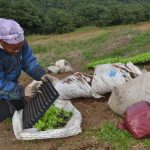
Adapted from the National Agro-meteorological Committee (NAC) Advisory for spring and early summer.
Above normal temperatures are expected, and above normal rainfall is anticipated for north-eastern half of the country during spring and early summer. With the above forecast in mind, the following strategies are recommended:
A. Rain-fed crop production
Soil choice
- Choose suitable soil type.
- Suitable soil and land use management practices that would control wind and water erosion in cultivated lands are suggested.
- Avoid marginal soils – shallow and low water holding capacity soils.
- Rather plant in soils with high water holding capacity or with shallow water table.
- Ascertain that the soil profile has enough water when planting commences.
- Roughen the soil surface to enhance rain water penetration and reduce runoff.
- Minimise compaction by reducing the passing of heavy machinery in the field.
- Add organic material to improve soil structure.
Land preparation
- Avoid where possible soils with pronounced plough pans.
- Consider practicing conservation agriculture such as zero or minimum tillage.
- Cover soil with organic matter or cover crops.
- Practice crop rotation.
- Do not expand land under crop production unnecessarily.
- Prioritise fallow land.
Crop choice and planting
- Choose drought resistant cultivars.
- Provide flexibility and diversification.
- Rather plant early in the season than late, but stay in the normal planting window and follow the weather and climate forecast regularly so as to make informed decisions.
- Consider staggered planting – spreading over weeks.
- Do not experiment with new and unknown cultivars and also avoid unnecessary capital investments.
- Consider intercropping for improved soil structure and pest/diseases control.
- Planting in a controlled environment (e.g. green house) is advisable where possible.
Crop management
- Adjust planting density accordingly.
- Consider mulching to minimize evaporation.
- Control weeds regularly.
- Consider a conservative fertilizing strategy during dry conditions.
- Consider organic fertilization.
- Scout for pests and diseases regularly and control where necessary.
- Practice water harvesting techniques e.g. construction of basins, contours, ridges.
B. Irrigation farming
- Remove all weeds containing seeds, but keep other vegetative rests on the land because that will reduce evaporation.
- Check and repair all tools and machinery especially where there are water leaks.
- Be aware of the state of regional water resources and whether it will be adequate for irrigation.
- Timing of irrigation – rather late afternoon or early evening to reduce evaporation.
- Manage irrigation so that the plant receives water only when needed.
- Consider using drip irrigation as it saves water by allowing it to drip slowly straight to the roots.
- Avoid over irrigation because that can create problems e.g. water logging and diseases.
- Adhere to water restrictions when issued.
C. Domestic and home garden water use
- Conserve existing water supplies.
- Eradicate water weeds.
- Limit water waste and losses.
- Repair leaking pipes.
- Re-use water and retain high quality.
- Harvest water during rainy days.
D. Stock farming
- Keep stocking rates conservative and even lower to protect grazing.
- Never exceed carrying capacity of plant associations.
- Provide lots of drinking points where possible.
- Provide additional fodder and enhance nutritional value of dry grazing/feed with licks:
- Phosphorous deficiency is a major problem.
- Licks should (in most cases) provide:
- Phosphorous.
- Urea (to help with the break-down of dry vegetation).
- Salt.
- Molasses.
- Deficiencies differ according to vegetation composition/soil properties/climate.
- Analysis of vegetation/soil samples can benefit the decision for supplement composition.
- Sell mature, marketable animals (to help prevent overstocking/ overgrazing).
- If grazing is in danger, herd animals into pens where different animals can be segregated and fed separately.
E. Grazing
- Subdivide your grazing area into camps of homogeneous units (in terms of species composition, slope, aspect, rainfall, temperature, soil and other factors) to minimise area selective grazing as well as to provide for the application of animal management and veld management practises such as resting and burning.
- Determine the carrying capacity of different plant associations.
- Calculate the stocking rate of each, and then decide the best ratios of large and small animals, and of grazers or browsers.
- Provide periodic full growing-season rests (in certain grazing areas) to allow veld vigour recovery in order to maintain veld productivity at a high level as well as to maintain the vigour of the preferred species.
- Do not overstock at any time to avoid overgrazing.
- Eradicate invader plants.
- Periodically reassess the grazing and feed available for the next few months, and start planning in advance.
- Spread water points evenly.
F. Pests and diseases
Crops
- Fruit crop farmers should regularly scout for pests and diseases and contact the local agricultural office for advice on best control measures. Farmers should further implement phytosanitary measures.
Livestock
- Follow the vaccine routine and consult with the local veterinarian.
G. Veld fires
The provinces and farmers are advised to maintain firebreaks in all areas. An owner of the land who is obliged to prepare and maintain a firebreak must ensure that, with due regard to the weather, climate, terrain and vegetation of the area, the following is taken care of in terms of installing firebreaks (Chapter 4 of the National Veld and Forest Fire Act No. 101 of 1998):
- It has to be wide enough and long enough to have a reasonable chance of preventing a veld fire from spreading to or from neighbouring land.
- It does not cause soil erosion and
- It is reasonably free of inflammable material capable of carrying a veld fire across it.
- Firebreaks may be temporary or permanent.
- Firebreaks should consist of fire-resistant vegetation, inflammable materials, bare ground or a combination of these.
- Firebreaks must be located in such a way as to minimize risk to the resources being protected.
- Erosion control measures must be installed at the firebreak.
Firebreaks can be made through the following methods:
- Mineral earth firebreak:
- Through ploughing, grading, other earth movement.
- Use of herbicides.
- Use animals to overgraze specifically to minimise fuel.
- Strategic placement of burned areas,
- Not to be done on days with fire hazard (windy and dry/hot).
- Plant fire resistant plants.
- Plant species selected for vegetated firebreaks must be non-invasive and capable of retarding the spread of fire.
Maintaining firebreaks:
- Mow, disk, or graze vegetative firebreaks to avoid a build-up of excess litter and to control weeds.
- Inspect all firebreaks for woody materials.
- Inspect firebreaks at least annually and rework bare ground firebreaks as necessary.
- Repair erosion control measures as necessary.
- Access by vehicles or people must also be controlled.
- Bare ground firebreaks, which are no longer needed must be stabilized i.e.
- Sow grass.
- Mulch.
What to do when conditions favourable for veld fire are forecast:
- Prohibit fires in the open air during periods of high fire hazard and establish a fire control committee.
- To control fires, an alarm system, firefighting teams, and beaters must be organized in advance and plans prepared.
- Livestock should be moved out of grazing land to a safe place.
What to do during a veld fire:
- Water is generally not available in sufficient quantities or at adequate pressure for the control of major fires; however, sand or other loose mineral soil material can be an effective method of control.
- Tree branches can be used to beat fire.
H. Erosion
Erosion is the wearing away of soil and rocks by the action of natural forces, for example, water and wind. The loose and dissolved materials move from one location to another. Erosion therefore may reduce agricultural production potential.
Preventative measures for erosion:
- Do not burn vegetation.
- Keep vegetation cover – e.g. shrubs, grass, small trees; a cover crop may be used to increase organic material and increase soil structure.
- Plant permanent vegetation e.g. perennial grasses where possible.
- Maintain any remaining vegetative cover, e.g. maize stubble during winter wheat sowing, as it acts as a blanket, traps eroded particles and reduces the wind speed at ground level.
- Plant evergreen trees growing densely and perpendicular to the typical wind direction during winter and spring as wind breaks.
- Increase water infiltration by correct management of soil e.g. reduce frequency of plough and use minimum tillage.
- Mulch: to increase infiltration, reduce evaporation, and reduce raindrop impact as well as wind erosion.
- Construct retaining walls around gardens.
- Avoid soil compaction by roughening the soil surface,
- Furrows and tillage ridges can trap loose soil.
- Farm along contours as this reduces slope lengths.
- Prevent overgrazing.
- Practice conservation farming
- Maximize retention of crop residues.
I. Heat stress – bad for productivity
Signs of heat stress:
- Bunching in shade, high respiratory rates, open mouth breathing.
What to do:
-
- Offer shade.
- Offer water- keep good quality water in front of animals.
- Wet with sprinklers/fire hose.
- Water ground.
- Avoid overworking animals.
- Control insects. Biting insects, such as flies can further stress livestock and interrupt their cooling. If pastures or buildings draw insects to livestock during times of extreme heat, provide proper insecticides or considering relocating your livestock.
Poultry
- Provide cool, clean, quality drinking water to your poultry. Water will help keep your birds cool.
- Always make sure your poultry is in a well-ventilated area in which there is nothing to obstruct the airflow.
- Provide feed during the coolest part of the day.
- Supplement drinking water with electrolytes.
- Reduce the number of birds kept in a house or in an area.
- Avoid excessive activity during the hottest part of the day.
J. Severe thunderstorms/flash floods
Building resilience:
- Identify resources/facilities within 50 km that can be utilized and can be of help during emergencies.
- Be sure to have legal and adequate markings to identify your livestock.
- Stay well informed about livestock in your possession and conduct an inventory after the event.
- Monitor television and local radio stations for information regarding severe storms/flash floods in your region.
- Identify natural or built areas/shelters where animals can be kept during such conditions
- Sufficient height to be above water level,
- Sheltered from strong winds and wetness,
- Restrict access to high-risk areas such as low lying fields close to streams.
- Store food in safe areas sheltered from wetness to be used after storms/flash floods.
- Keep pesticides and other chemicals in areas where water will not be contaminated during extreme rainfall/storm events.
- Inspect/repair farm dams before rainy season, and after each event.
The winter season received good rains in some parts of the winter rainfall areas. The remainder of the country was generally dry with reasonable to poor livestock and veld conditions. Winter crops were reported to be in good condition, particularly those under irrigation. Above-normal rainfall is expected for the north-eastern half of the country in spring to early summer seasons.
Temperatures are expected to be above normal countrywide. Farmers are still advised to keep livestock in balance with the available grazing and provide additional feed such as relevant licks. They should also provide enough water points on the farms as well as shelter during bad weather conditions.
Farmers must continually conserve resources in accordance with the Conservation of Agricultural Resources Act 1983, (Act No. 43 of 1983). All farmers should follow the weather and climate forecasts regularly so as to make informed decisions.
Veld fires have been reported in several provinces in the summer rainfall areas. Conditions remain conducive for veld fires in summer rainfall areas due to the high fuel load as a result of rains received during the previous summer season. Therefore, construction and maintenance of fire belts should be prioritized as well as adherence to veld fire warnings. Measures for these should be in place. Farmers are encouraged to implement strategies provided in the early warning information issued.
The users are urged to continuously monitor, evaluate, report and attend to current Disaster Risk Reduction issues. It is very important and mandatory for farming communities to always implement disaster risk measures and maintain good farming practices.
The climate advisory should be disseminated widely. Users are advised to be on the look-out and act on the daily extreme weather warnings as well as the monthly advisory. Information sharing groups are encouraged especially among farming communities for sustainable development. In general, effective communication among all stakeholders in the sector will enhance effective implementation of risk reduction measures/early warning services. It is the responsibility of farmers to implement disaster risk measures.
The Disaster Management Act 2002, (Act No. 57 of 2002) urges provinces, individuals and farmers, to assess and prevent or reduce the risk of disasters using early warning information. The current advisory can be accessed from the following websites: www.dalrrd.gov.za.
Photo by Inge Maria on Unsplash
Relevant pages on AgribookDigital include “Weather and climate“, “Climate change and global warming” and “Risk management and insurance“.







